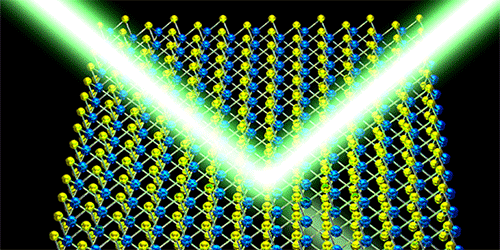The New Thinnest Mirrors in the World Use Quantum 'Excitons' to Reflect Light

Two separate teams of scientists have built the thinnest mirrors in the world: sheets of molybdenum diselenide (MoSe2), each just a single atom wide.
The mirrors were developed at the same time at Harvard University and the Institute for Quantum Electronics in Zurich, and described in a pair of papers published Thursday (Jan. 18) in the journal Physical Review Letters. These engineering feats push the limits of what's possible in this physical universe, the researchers said.
Despite approaching the minimum thickness an object could possibly have and remain reflective under the laws of physics, the tiny mirrors reflected a great deal of the light shone on them. The Harvard mirror, mounted on a silicon base, reflected 85 percent of the light that struck it, the first paper said. The Zurich mirror, mounted on silica (an oxidized form of silicon), reflected 41 percent, the Swiss research said. Both mirrors reflected light in the 780-nanometer range, a deep red. [Beyond Silicon: 8 Chemical Elements You Never Heard Of]
That feat of engineering is interesting all on its own. But the researchers wrote that their thin mirrors could be useful, playing important roles in very small, specialized sensors and computer chips that use laser beams to carry information.
Exciting excitons
MoSe2 works as a mirror because of the very specific ways electrons behave as they surround the material's nuclei. As a previous paper published in September 2017 described, this substance tends to form gaps in its electron fields — areas where an electron could orbit, but no electron is present,.
Smash a photon, or particle of light, into an atom, and an electron has a good chance of jumping from a lower-energy orbit to a higher-energy orbit. Once that happens, a gap called an "electron hole" forms in the electron field. Electrons surrounding MoSe2 are especially likely to behave this way when hit with certain wavelengths of light.
Electrons are negatively charged quantum objects. And the protons in atomic nuclei are positively charged. So, and this is the tricky bit, those electron holes take on some of the positive charge from the protons in the nuclei. That allows the holes to behave a bit like particles, even though they're really the absence of particles.
Get the Space.com Newsletter
Breaking space news, the latest updates on rocket launches, skywatching events and more!
Nearby, negatively charged electrons attract those fake particles, and under certain circumstances, pair up with them to form weird quantum-mechanical objects called excitons. Those excitons emit light of their own, interfering with incoming light and sending it back the way it came — just like the mirror in your bathroom.
Mirror tuning
These ultra-thin mirrors turn out to have a lot of real-world potential. Optoelectronic engineers — people who work on tiny optical chips, fiber-optic networks, and other devices that rely on tightly controlling small beams of photons — could benefit from even a normal mirror that's just one atom wide.
But, the researchers wrote, MoSe2 works as more than just a tiny mirror. Depending on the electrical charge applied to the substance, MoSe2's reflectivity goes up or down. And that on-off effect happens super quickly, fast enough, the Zurich team wrote, for it to be useful in several high-speed computing applications.
Originally published on Live Science.
Join our Space Forums to keep talking space on the latest missions, night sky and more! And if you have a news tip, correction or comment, let us know at: community@space.com.

Rafi wrote for Live Science from 2017 until 2021, when he became a technical writer for IBM Quantum. He has a bachelor's degree in journalism from Northwestern University’s Medill School of journalism. You can find his past science reporting at Inverse, Business Insider and Popular Science, and his past photojournalism on the Flash90 wire service and in the pages of The Courier Post of southern New Jersey.










